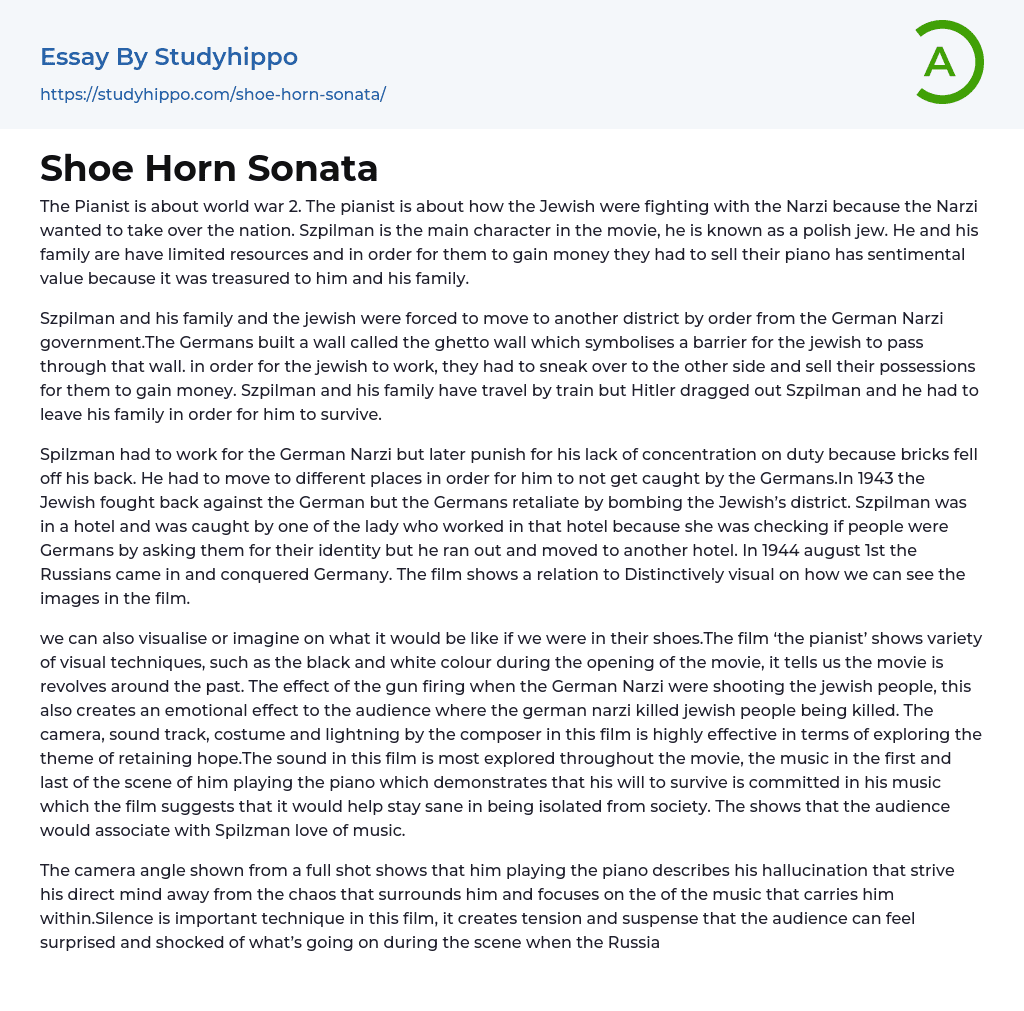The movie "The Pianist" depicts the Jewish resistance during World War 2 against the Narzi who aimed to gain control of the nation. The protagonist, Szpilman, is a Polish Jew who comes from a family with limited resources. In order to make ends meet, they were forced to sell their piano, which held sentimental value for them.
Szpilman, his family, and other Jewish people were compelled by an edict from the German Nazi government to relocate to a different district. They found themselves facing the ghetto wall, which served as a mere symbol of the obstacles separating them from other communities. The Jewish had to sneak past it to sell their belongings and work for a living. Despite having traveled by train with his family, Hitler pulled Szpilman aside, forcing him to leave them behind to save himself.
Spil
...zman worked for the German Narzi but was punished for lack of concentration when bricks fell off his back. He had to constantly move around to avoid being caught by the Germans. In 1943, the Jewish people fought back against the Germans which resulted in the Germans retaliating by bombing their district. Szpilman was caught by a lady working at a hotel when she checked for identity but he managed to escape and move to another hotel. On August 1st, 1944, the Russians conquered Germany. The film demonstrates how Distinctively Visual can illustrate the images portrayed.
By putting ourselves in their shoes, we can gain a better understanding of their experiences. In the film 'The Pianist', various visual techniques are used to convey meaning, such as the black and white color scheme in the opening, which indicates that th
movie is set in the past. The sound of gunshots when the German Narzi killed Jewish people creates an emotional effect on the audience. The composer effectively uses camera angles, soundtracks, costumes, and lighting to explore the theme of retaining hope. Sound is particularly important throughout the movie, and the music played by Spilzman on the piano in the beginning and end scenes demonstrates his determination to survive and stay sane despite isolation from society. This love of music is something that audiences can relate to.
The piano playing provides an escape from the chaos around him, with the camera angle showing a full shot of the pianist lost in his hallucination. Silence is effectively used to create tension in the film, leading to surprise when the Russians launch a surprise attack on the Germans with military weapons. The opening scene featuring a visual echo of the pianist emphasizes his character's consistency throughout the movie. A high angle shot shows him playing during a German assault on slave workers, where he must escape to avoid detection.
The book ‘The shoe horn sonata’ by John Misto showcases the composer's portrayal of the women in the POW camp as being punished and emotionally devastated, with some even being killed due to the war. Through their perspective, the composer manages to evoke emotions in the audience in an attempt to make them visualize the torture being inflicted upon them. The dialogue “for the first time in years I had a smile on my face” highlights the connection and empathy that ultimately brings happiness. Stage directions such as “Bride slaps shiela” indicate a shift in friendship while dialogue such as “completely
cut off from the entire world” signifies Sheila's isolation and inability to escape. “You should have let me die” represents anger and frustration towards Sheila while “I was petrified” shows Bridie's vulnerability.
The use of dialogue in 'We're Going to Survive' displays the composer's ability to portray a resolute will to survive without any doubts or fears. This emotional plot is successfully demonstrated. In Roman Polanski's 'The Pianist', the director uses camera angles to showcase Spilzman's isolation as he plays the piano at a destroyed building. The position of Spilzman on the ground being whipped by a German also indicates discrimination. The filmmaker employs black and white colour in the first scene to connect the film to the past, and uses an extreme long shot from the city.
In the scene where the Russians invade the Germans, a long shot shows Spilzman at the hotel. The sound effects of the Germans shooting the Jewish people reveal discrimination based on race, creating an emotional moment for the audience. Additionally, a close-up shot of a persona eating a caramel bar highlights the limited food options available. Thus, the composer effectively showcases discrimination from one side in the film.
- Elie Wiesel essays
- Nazi Party essays
- Weimar Republic essays
- Holocaust essays
- Adolf Hitler essays
- Concentration Camps essays
- Anne Frank essays
- 1920S essays
- 1950S essays
- 1960S essays
- 19Th Century essays
- 20Th Century essays
- Ancient Greece essays
- Bravery essays
- British Empire essays
- Civilization essays
- Colonialism essays
- Declaration of Independence essays
- Evidence essays
- Genocide essays
- Gilded Age essays
- Historical Figures essays
- Historiography essays
- History of the United States essays
- Letter from Birmingham Jail essays
- Louisiana Purchase essays
- Nazi Germany essays
- Rebellion essays
- Revolution essays
- Roman Empire essays
- Russian Empire essays
- The Columbian Exchange essays
- Vikings essays
- War essays
- What is History essays
- World History essays
- World Hunger essays
- Band essays
- Baroque Music essays
- Blues essays
- Classical Concert essays
- Classical Music essays
- Concert essays
- Hip Hop essays
- Jazz essays
- Ludwig Van Beethoven essays
- Michael Jackson essays
- Mp3 essays
- Music Concert Report essays
- Music Reference essays




